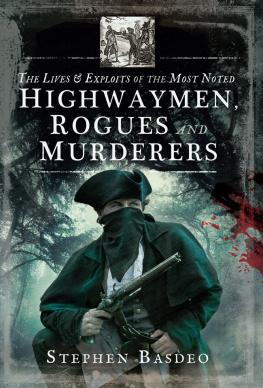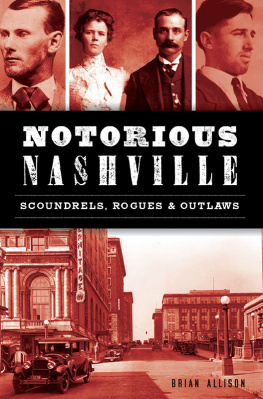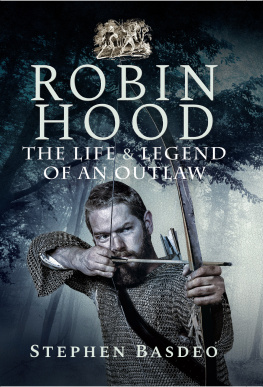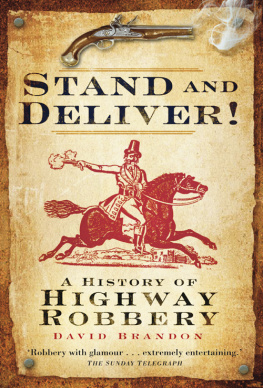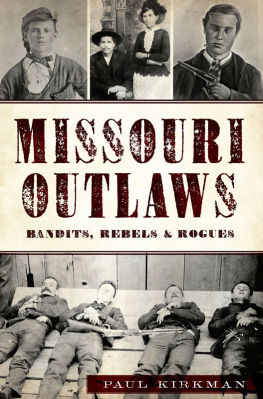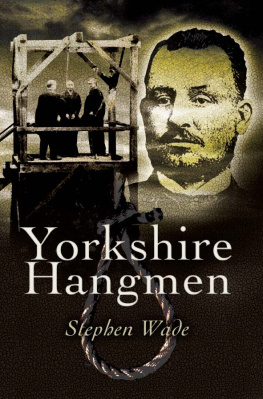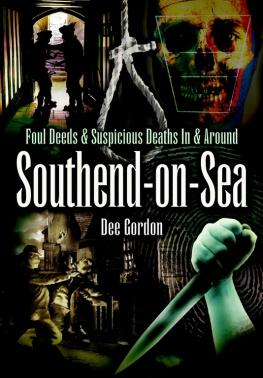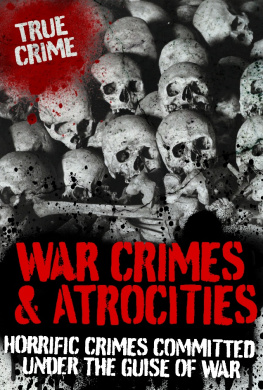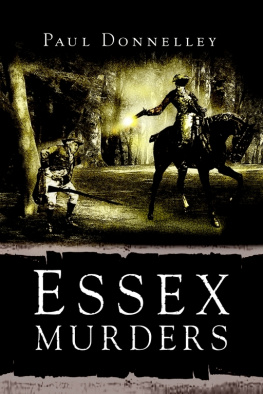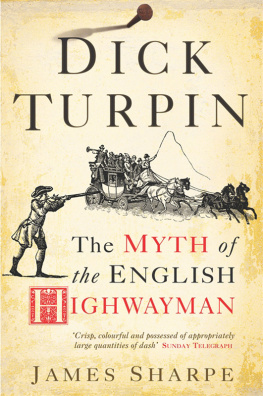Pagebreaks of the print version

THE LIVES AND EXPLOITS OF THE MOST NOTED
HIGHWAYMEN, ROGUES, AND MURDERERS
Dedicated to Ernest, Audrey & Benjamin Trundley
(Whether they would have approved of having their names attached to a book containing the life stories notorious thieves, murderers, scoundrels, and reprobates well, Im not too sure)
THE LIVES AND EXPLOITS OF THE MOST NOTED
HIGHWAYMEN, ROGUES, AND MURDERERS
STEPHEN BASDEO
First published in Great Britain in 2018 by
PEN AND SWORD HISTORY
an imprint of
Pen and Sword Books Ltd
47 Church Street
Barnsley
South Yorkshire S70 2AS
Copyright Stephen Basdeo, 2018
ISBN 978 1 52671 316 2
eISBN 978 1 52671 318 6
Mobi ISBN 978 1 52671 317 9
The right of Stephen Basdeo to be identified as the author of this work has been asserted by her in accordance with the Copyright, Designs and Patents Act 1988.
A CIP record for this book is available from the British Library All rights reserved. No part of this book may be reproduced or transmitted in any form or by any means, electronic or mechanical including photocopying, recording or by any information storage and retrieval system, without permission from the Publisher in writing.
Pen & Sword Books Ltd incorporates the imprints of Pen & Sword Archaeology, Atlas, Aviation, Battleground, Discovery, Family History, History, Maritime, Military, Naval, Politics, Railways, Select, Social History, Transport, True Crime, Claymore Press, Frontline Books, Leo Cooper, Praetorian Press, Remember When, Seaforth Publishing and Wharncliffe.
For a complete list of Pen and Sword titles please contact
Pen and Sword Books Limited
47 Church Street, Barnsley, South Yorkshire, S70 2AS, England
E-mail:
Website: www.pen-and-sword.co.uk
********
To the READER
Instead of the ERRATA.
This rogue hath had his faults, the printers too; All men whilst here do erre; and so may you.
********
Errata notice from Richard Heads The English Rogue (1665)
Acknowledgements
First off, I would like to thank, as always, my family; my parents, Debbie and Joseph Basdeo, and my sister, Jamila and her family. The emotional support from them that I have received while I was writing this book as well as finishing off my PhD thesis has been invaluable. My friends, Rich, Sam, Chris, and Myk also get a big kiss from me. And of course, my cat, Robin, named after the original and greatest highwayman, Robin Hood.
An additional note of thanks goes to my supervisors, Professor Paul Hardwick, Professor Rosemary Mitchell, and Dr Alaric Hall, of the University of Leeds, for being generally awesome and helping me to develop my skills as a writer. Paul is particularly good at highlighting the fact, in all of my writing, that when I am referring to a historical text I should speak about it in the historic present because the text still physically exists the text says instead of the text said. Hopefully, I have not fallen back into this bad habit in this book. Also, Professor Heather Shore from Leeds Beckett deserves many thanks; it was under her guidance and supervision that I completed two crime-related theses while studying for both my BA and MA degrees in history.
Another word of gratitude goes to my friend, Allen Wright, whose Bold Outlaw website has been invaluable for everyone interested in researching the legend of Robin Hood, and certainly helped me in drafting a PhD research proposal back in 2014, and whose work has once again been useful for me in writing this book. Finally, the lovely people at Pen and Sword Books who have helped make this book possible: Jonathan Wright (my commissioning editor); Laura Hirst; and Lauren Burton; and of course the design team at P&S who patiently tolerated the numerous amendments I made to the supposedly final manuscript of Wat Tyler ! And last, but certainly by no means least, my editor, Carol Trow many thanks!
Preface
Let us the road.
Hark! I hear the sound of coaches!
The hour of attack approaches,
To your arms, brave boys, and load.
See the ball I hold!
Let the chymists toil like asses,
Our fire their fire surpasses,
And turns all our lead to gold.
John Gay, The Beggars Opera (1728)
There are few subjects that interest us more generally, than the adventures of robbers and banditti. In our infancy they awaken and rivet our attention as much as the best fairy tales, and when our happy credulity in all things is woefully abated, and our faith in the supernatural fled, we still retain our taste for the adventurous deeds and wild lives of brigands.
Charles Macfarlane, Lives of the Banditti (1833)
Macfarlanes words generally ring true. In our youth, many of us were entertained with tales of robbers and bandits. Ask people what their favourite Disney movie was when they were growing up and it is likely that some of them will refer to Disneys Robin Hood (1973). As people grow older, they may develop an interest in watching films and television shows featuring the suave mobster, or the police procedural which depicts the lives of those who catch criminals. As entertainment, crime sells, and it has been the same since the early modern period. The present work, in fact, is intended as a successor to a popular genre of literature that flourished during the eighteenth century; the criminal biography. In works such as Alexander Smiths A Complete History of the Lives and Robberies of the Most Notorious Highwaymen (1719), Charles Johnsons Lives of the Most Remarkable Criminals (1735), The Newgate Calendar (1774), and The Criminal Recorder (1804), the lives of notorious offenders were sensationalised for an enthusiastic audience hungry to gain a glimpse into the lives of the criminal other. It is from books such as these that people in the eighteenth century gained their understanding of crime and the criminal underworld. Even today, our understanding of notorious criminals and their modus operandi is to a large extent shaped by popular culture; their life stories are told in newspapers, magazines, novels, television dramas, and in movies. For many of the medieval and early modern outlaws who are featured in this book, much of what we know of their lives comes not from trial reports, but from ballads and pamphlets printed after their deaths. Before entering into our history of the most notorious highwaymen, let us gain a brief overview of the development of crime literature throughout the centuries, we can see the connections between criminals, public perceptions of crime, and popular culture.
There are few writings pertaining to bandits that have survived from the ancient world, and were it not for the various laws enacted against highway robbers during the period, we would have very little information on these early rogues at all. The Bible (if we lay religious ideology aside momentarily) tells us that banditry and highway robbery was a common feature of life in the ancient world. The only works from Europe during antiquity that enter into any significant detail upon the lives of individual bandits are the writings of Cassius Dio (155235AD) and Herodian (170240AD). These mens writings certainly cannot be classed as crime literature as we would understand the genre today, but they do provide a small amount of information on two highway robbers named Bulla Felix and Maternus. Felixs story is included in the appendix because it offers some interesting parallels to medieval and early modern Robin Hood stories.

